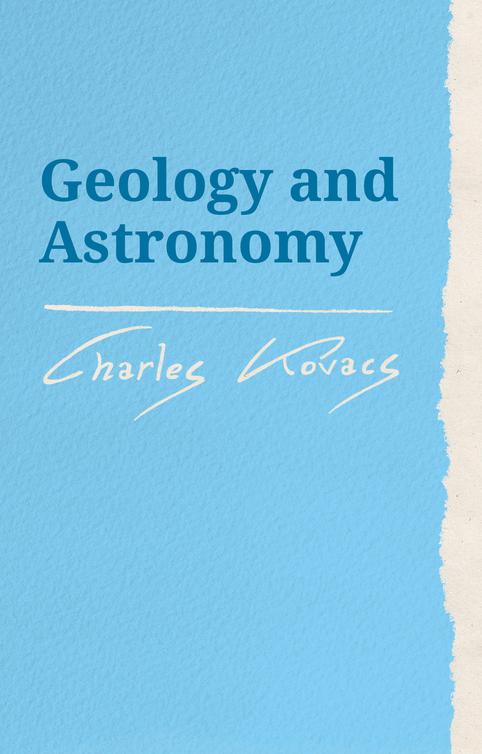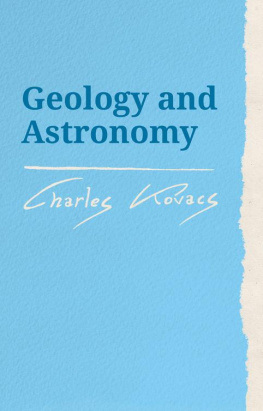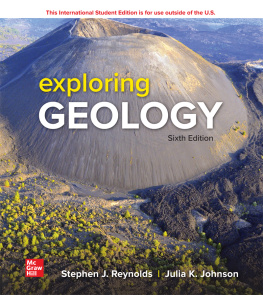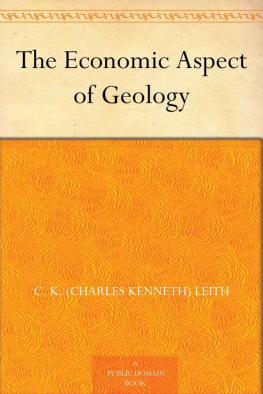Charles Kovacs - Geology and Astronomy
Here you can read online Charles Kovacs - Geology and Astronomy full text of the book (entire story) in english for free. Download pdf and epub, get meaning, cover and reviews about this ebook. year: 2020, publisher: Floris Books, genre: Children. Description of the work, (preface) as well as reviews are available. Best literature library LitArk.com created for fans of good reading and offers a wide selection of genres:
Romance novel
Science fiction
Adventure
Detective
Science
History
Home and family
Prose
Art
Politics
Computer
Non-fiction
Religion
Business
Children
Humor
Choose a favorite category and find really read worthwhile books. Enjoy immersion in the world of imagination, feel the emotions of the characters or learn something new for yourself, make an fascinating discovery.
- Book:Geology and Astronomy
- Author:
- Publisher:Floris Books
- Genre:
- Year:2020
- Rating:3 / 5
- Favourites:Add to favourites
- Your mark:
- 60
- 1
- 2
- 3
- 4
- 5
Geology and Astronomy: summary, description and annotation
We offer to read an annotation, description, summary or preface (depends on what the author of the book "Geology and Astronomy" wrote himself). If you haven't found the necessary information about the book — write in the comments, we will try to find it.
Geology and Astronomy — read online for free the complete book (whole text) full work
Below is the text of the book, divided by pages. System saving the place of the last page read, allows you to conveniently read the book "Geology and Astronomy" online for free, without having to search again every time where you left off. Put a bookmark, and you can go to the page where you finished reading at any time.
Font size:
Interval:
Bookmark:

This book contains the lesson notes of Charles Kovacs, made when he was a class teacher of Class 6 pupils in Edinburgh. To some extent they have been revised and updated. In the geology notes the local area in this case Edinburgh is emphasised, and this is quite deliberate, as it serves as an example of relating what has been learned to the familiar, local area. One might expect lessons on geology to start from a description of Plate Tectonics the great discovery arrived at during the 1960s. But this is the point modern geology had existed for nearly 200 years and was a very advanced science before these discoveries could be made and appreciated. It is all too easy to give children ready-made conclusions; conclusions which, in reality, evolved only gradually. The unfortunate result can then be that the conclusions are indeed accepted, but accepted as somewhat undigested dogma, not truly understood. The consideration of Plate Tectonics might come much better in the ninth grade, when time can be spent considering the diverse evidence the detective story which, eventually, led to such astonishing conclusions about the structure of the Earth.
In astronomy too the approach is to start from observations of sun, moon and stars phenomena which have been experienced and understood without special equipment or theories for millennia. Once again, the upper grades are a better place to consider how the more recent concepts evolved. The later chapters on discoveries with the telescope are the most difficult to keep up to date, as new discoveries are continually being made, both with more powerful telescopes and with space probes.
We hope that these notes can serve as a stimulus to the creativity of individual teachers, rather than be followed as a scheme. This would be in keeping with the wishes of Charles Kovacs.
Howard Copland
In the winter it can get very cold, but no matter how cold it can get here in our part of the world, there are places where it can get much, much colder. In which direction would we travel to find lands where it gets much colder than here? Would it be east, where the sun rises? South, where the sun stands highest at noon? West, where the sun sets? Or north, the direction in which we never see the sun moving across the sky? To find the colder lands we would travel north.
Travelling north we would come to lands which are much colder than ours; and the further we go north the colder it would get, until we come to parts of the world which are so cold that the ice and snow never melt completely and the ground is always frozen summer and winter. Think of Greenland, Northern Canada, Alaska or Northern Russia. These are the lands around the North Pole, the polar region, the region of everlasting ice and snow.
On such a journey to the frozen north we would discover something else. We would notice something about the plants. In our part of the world there are two kinds of trees. First the leafy trees which, every winter, shed their leaves and stand bare. Then there are the trees that have only green needles for leaves; in botany we call them conifers or evergreens. Here, in our part of the world, we have these two kinds of trees, but going further north the leafy trees get fewer and fewer. There you would hardly see anything but the dark green of pines, firs and larches; the trees which have green needles as leaves.
Can you guess why this is so, why the trees with broad leaves get fewer and fewer the further we go north? Because a broad leaf tree needs more sun and cannot stand being frozen. Where there is less sunlight and it is less warm the trees with narrow leaves, or needles, can live better than the others. One could say that the leaves shrink and become needles as we go further north. Not only the leaves shrink as you go north; the trees themselves get smaller. The pines, firs and larches that grow far to the north of us are like dwarfs compared with our trees; they would barely reach to your shoulders. In the regions where these dwarf trees grow there is still a kind of summer. The snow does melt and then plants and flowers grow and have lovely blossoms; but they all have only tiny, tiny stalks, much shorter stalks than our flowers here. If we go still further north we come to the regions where nothing grows at all not even dwarf trees or tiny flowers. These are the regions near the North Pole, the regions of everlasting ice.
But how would things change if we travelled further and further south in the direction where the sun stands at its highest at noon? We know of course that it would get warmer and warmer. We would come to lands where people never have winter. How do the plants change as we go further south? Going south the needle trees become fewer and fewer, as they dont like too much sunlight, and the leafy trees increase; we come to trees with very large leaves indeed, like the palm trees. Think how long and broad and thick the palm leaves are. The trees also get taller and the other plants, the flowers, shoot up too. They have long stalks, long leaves and large blossoms in the hot lands of the tropics.
So you see how the whole earth changes from north to south. In the south, in the tropics, it is always summer it is sunny and hot and we find tall trees, long stalks, big leaves and large flowers. The further north we go the trees are smaller, the leaves shrink, the stalks get shorter and, in the end, we come to lands where it is always winter and there is always ice and snow. Of course if you go beyond the equator, as far south as you can go, you finally end up at the South Pole and it is again extremely cold.
What I have just described is about the whole earth. The whole earth changes like this from south to north, or from equator to pole. But think of a very high mountain. Let us take the highest mountains there are in the world; the Himalayas. At the foot of the Himalayas you have a hot climate, the hot weather of India. You would see tall, broad-leaved flowers and trees. But as you go up into the mountains the air gets cooler and cooler, and the trees and plants become smaller. At a certain height you might think you are in Scotland there are pines, larches, there is even heather, but there are also oak trees and beech trees. You go still higher and soon there are only needle trees and they become smaller. There are mountain flowers, like gentian, with short stalks. If you go still higher up there is, again, everlasting snow and ice. The summits of such high mountains are just like the polar regions and nothing can grow in the frozen, snow-covered heights.
Every high mountain is like the whole earth. Just as children often look like their father or their mother, so the high mountains of the earth are children of the earth, and they have a likeness to their mother, the earth.
The hills and mountains of Scotland are very beautiful, but even our highest mountains in Scotland, the Cairngorms and Ben Nevis, cannot give you the kind of feeling that you have when you stand before the really high mountains of the world. If you have never seen the Alps before and are in Switzerland for the first time it can happen that you look up into the sky and think, Thats a strangely shaped white cloud up there. But when you look again, you see that it is not a cloud at all, but a range of snow-white mountain peaks, towering in the sky.
These mighty, powerful, majestic giants, reaching up into the clouds, leave you feeling something like awe before that power and greatness. But looking at these towering peaks you can also feel how immeasurably old these giants are. They have stood there for millions of years and they will stand there for millions of years to come. If these mighty peaks could speak they would tell us the life story of earth itself. We walk on the earth, we build our houses and cities on the earth and we use stones taken from the earth for our buildings, but what do we know about the story of the earth? The ancient, mighty mountains can tell us something about the story of the earth. Let us see what the mountains can tell us.
Font size:
Interval:
Bookmark:
Similar books «Geology and Astronomy»
Look at similar books to Geology and Astronomy. We have selected literature similar in name and meaning in the hope of providing readers with more options to find new, interesting, not yet read works.
Discussion, reviews of the book Geology and Astronomy and just readers' own opinions. Leave your comments, write what you think about the work, its meaning or the main characters. Specify what exactly you liked and what you didn't like, and why you think so.













